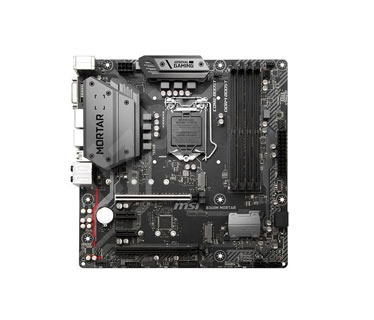

The board also features an RGB output should you decide to buy a standard RGB LED light strip (up to 2M in length). To pretty things up a bit, the board features red LED lighting to create a soft glow under the board and around the sound card. If you choose to use the 3.5mm jacks for analog output, expect rich and warm sound thanks to Chemi-Con audio capacitors. Power leaves the board with gold plated 3.5mm jacks, Optical, or the HDMI/DisplayPort digital audio if your devices support it. It comes with a high quality audio DAC that’s EMI-shielded to eliminate unwanted noise. Some other notable features remind you that this is a modern board. Check out the videos for much more detail on the board, UEFI, and OS Software. So far this board has worked without a fault. I’m also happy that I have a new USB-C connector on board and support for the fastest memory with NVME and Intel Optane. Even though this is a non-overclocking model (See the Z270M Mortar for that), the high quality VRMs mean my machine will remain incredibly stable for the foreseeable future. MSI loaded this board with high quality VRMs (4 + 2 config) which is what delivers stable power to the CPU. The UEFI is simply amazing and allows a large range of feature adjustment. I take comfort in knowing I have the latest chipset from a reputable brand. This alone was enough for me to choose this board, however there’s more to it. This kept my build cost very low, simple, and capable. This means, with a simple adapter like the Accell DisplayPort to HDMI 2.0 adapter, you can get 4k at 60 frames per second without having to purchase a new video card or much more expensive motherboard. DisplayPort 1.2 DOES support 4k 60 fps however. You need HDMI 2.0 for that, which is typically very expensive on a motherboard or requires the purchase of a video card like an Nvidia 1050 or higher.

I know many of you could care less for either feature, but here’s something incredibly important to consider. It’s a simple set of features, but all the boards under $100 either drop the DisplayPort or USB-C connector. MSI offers a huge range of boards, but for under $100, this is the only Micro-ATX board, from any brand, that has the following combination in one model:
B250m mortar cpu led series#
So that forced us to use a new 200 series chipset which in turn has many options to choose from. We knew it had to have Kaby Lake support, but I also didn’t want the hassle of flashing the BIOS on a 100 series chipset motherboard from last year. So we sought out what would make the most sense for an HTPC build on a budget. The other piece to the puzzle is an HDMI 2.0 port, which most/all budget motherboards do not have. This includes the least expensive Intel Celeron variant. If you want to watch Netflix in 4k at 60fps on your computer, you must have a Kaby Lake CPU (at least for now). As some of you may know, the new Intel Kaby Lake CPUs have built in 4k 60fps support with a 10-bit HEVC decoder. This particular board was sought out for an HTPC. They’ve made motherbaords for decades now, and have a ridiculous track record and experience. MSI is no stranger to the motherboard scene.


 0 kommentar(er)
0 kommentar(er)
